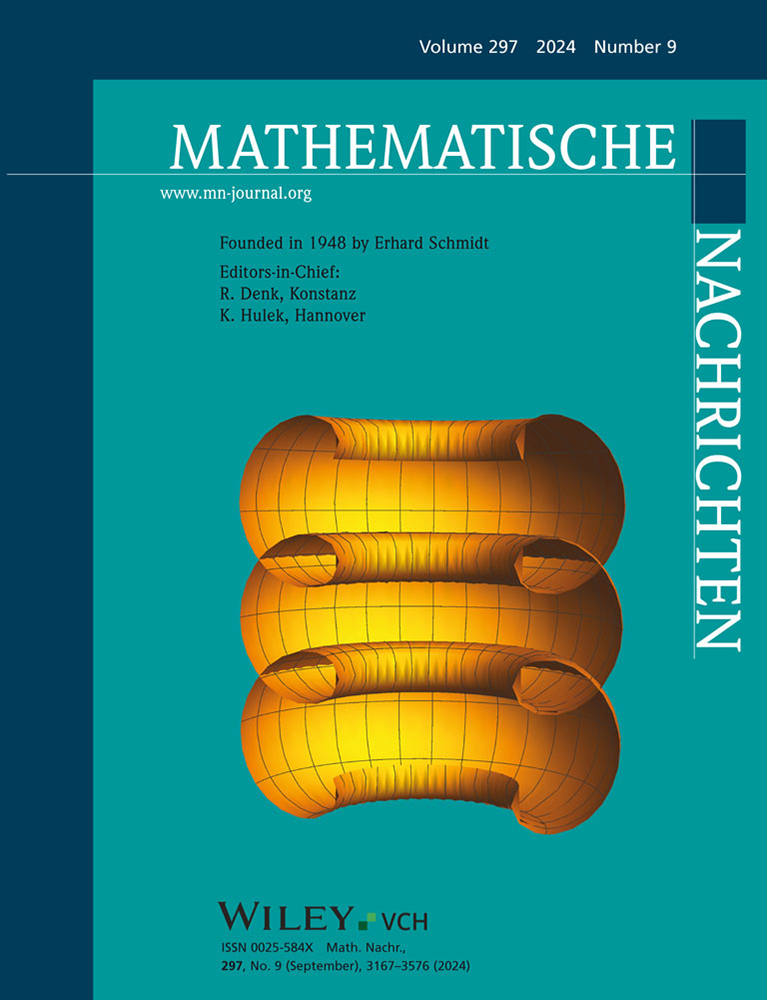Approximation theorem for the Kawahara operator and its application in the control theory
Corresponding Author
Roberto de A. Capistrano-Filho
Departamento de Matemática, Universidade Federal de Pernambuco, Recife (PE), Brazil
Correspondence
Roberto de A. Capistrano-Filho, Departamento de Matemática, Universidade Federal de Pernambuco, Av.Jornalista Aníbal Fernandes, s/n, Cidade Universitária, Recife (PE) 50740-560, Brazil.
Email: [email protected]
Search for more papers by this authorLuan S. de Sousa
Núcleo de Formação Docente, Universidade Federal de Pernambuco, Caruaru, Brazil
Search for more papers by this authorFernando A. Gallego
Departamento de Matemática, Universidad Nacional de Colombia (UNAL), Manizales, Colombia
Search for more papers by this authorCorresponding Author
Roberto de A. Capistrano-Filho
Departamento de Matemática, Universidade Federal de Pernambuco, Recife (PE), Brazil
Correspondence
Roberto de A. Capistrano-Filho, Departamento de Matemática, Universidade Federal de Pernambuco, Av.Jornalista Aníbal Fernandes, s/n, Cidade Universitária, Recife (PE) 50740-560, Brazil.
Email: [email protected]
Search for more papers by this authorLuan S. de Sousa
Núcleo de Formação Docente, Universidade Federal de Pernambuco, Caruaru, Brazil
Search for more papers by this authorFernando A. Gallego
Departamento de Matemática, Universidad Nacional de Colombia (UNAL), Manizales, Colombia
Search for more papers by this authorAbstract
Control properties of the Kawahara equation are considered when the equation is posed on an unbounded domain. Precisely, the paper's main results are related to an approximation theorem that ensures the exact (internal) controllability in . Following [23], the problem is reduced to prove an approximate theorem which is achieved thanks to a global Carleman estimate for the Kawahara operator.
REFERENCES
- 1F. D. Araruna, R. A. Capistrano-Filho, and G. G. Doronin, Energy decay for the modified Kawahara equation posed in a bounded domain, J. Math. Anal. Appl. 385 (2012), no. 2, 743–756.
- 2N. Berloff and L. Howard, Solitary and periodic solutions of nonlinear nonintegrable equations, Stud. Appl. Math. 99 (1997), no. 1, 1–24.
- 3A. Biswas, Solitary wave solution for the generalized Kawahara equation, Appl. Math. Lett. 22 (2009), 208–210.
- 4J. P. Boyd, Weakly non-local solitons for capillary-gravity waves: fifth-degree Korteweg–de Vries equation, Phys. D 48 (1991), 129–146.
- 5R. A. Capistrano-Filho and M. M. de S. Gomes, Well-posedness and controllability of Kawahara equation in weighted Sobolev spaces, Nonlinear Anal. 207 (2021), 1–24.
- 6R. A. Capistrano-Filho and L. S. de Sousa, Control results with overdetermination condition for higher order dispersive system, J. Math. Anal. Appl. 506 (2022), no. 1, 1–22.
- 7R. A. Capistrano-Filho, L. S. de Sousa, and F. A. Gallego, Control of Kawahara equation with overdetermination condition: the unbounded cases, Math. Meth. Appl. Sci. 46 (2023), 15162–15185.
- 8M. Cavalcante and C. Kwak, The initial-boundary value problem for the Kawahara equation on the half line, Nonlinear Differ. Equ. Appl. 27 (2020), no. 45, 1–50.
- 9M. Chen, Internal controllability of the Kawahara equation on a bounded domain, Nonlinear Anal. 185 (2019), 356–373.
- 10S. B. Cui, D. G. Deng, and S. P. Tao, Global existence of solutions for the Cauchy problem of the Kawahara equation with initial data, Acta Math. Sin. 22 (2006), 1457–1466.
- 11A. V. Fursikov and O. Y. Imanuvilov, On controllability of certain systems simulating a fluid flow, in: M. D. Gunzburger (ed.), Flow Control, IMA Vol. Math. Appl., vol. 68, Springer-Verlag, New York, 1995, pp. 149–184.
10.1007/978-1-4612-2526-3_7 Google Scholar
- 12F. A. Gallego, Controllability aspects of the Korteweg–de Vries Burgers equation on unbounded domains, J. Math. Anal. Appl. 461 (2018), no. 1, 947–970.
- 13H. Hasimoto, Water waves, Kagaku 40 (1970), 401–408 [Japanese].
- 14L. Hörmander, The analysis of linear partial differential operators I, Springer-Verlag, New York, 1983.
10.1007/978-3-642-96750-4 Google Scholar
- 15J. K. Hunter and J. Scheurle, Existence of perturbed solitary wave solutions to a model equation for water waves, Physica D 32 (1988), 253–268.
- 16T. Iguchi, A long -wave approximation for capillary-gravity waves and the Kawahara equations, Acad. Sin. 2 (2007), no. 2, 179–220.
- 17L. Jin, Application of variational iteration method and homotopy perturbation method to the modified Kawahara equation, Math. Comput. Modell. 49 (2009), 573–578.
10.1016/j.mcm.2008.06.017 Google Scholar
- 18T. Kawahara, Oscillatory solitary waves in dispersive media, J. Phys. Soc. Japan 33 (1972), 260–264.
- 19T. Kakutani, Axially symmetric stagnation-point flow of an electrically conducting fluid under transverse magnetic field, J. Phys. Soc. Japan 15 (1960), 688–695.
- 20D. Kaya and K. Al-Khaled, A numerical comparison of a Kawahara equation, Phys. Lett. A 363 (2007), no. 5–6, 433–439.
- 21V. Komornik, Exact controllability and stabilization, The Multiplier Method Collection, RMA, vol. 36, Paris Masson, 1994.
- 22V. Komornik and P. Loreti, Fourier series in control theory, Springer Verlag, 2005.
10.1007/b139040 Google Scholar
- 23L. Rosier, Exact boundary controllability for the linear Korteweg–de Vries equation on the half–line, SIAM J. Control Optim. 39 (2000), no. 2, 331–351.
- 24N. Polat, D. Kaya, and H. I. Tutalar, An analytic and numerical solution to a modified Kawahara equation and a convergence analysis of the method, Appl. Math. Comput. 179 (2006), 466–472.
- 25Y. Pomeau, A. Ramani, and B. Grammaticos, Structural stability of the Korteweg–de Vries solitons under a singular perturbation, Physica D 31 (1988), 127–134.
- 26E. Yusufoglu, A. Bekir, and M. Alp, Periodic and solitary wave solutions of Kawahara and modified Kawahara equations by using sine–cosine method, Chaos Solitons Fractals. 37 (2008), 1193–1197.
- 27B.-Y Zhang and X. Zhao, Control and stabilization of the Kawahara equation on a periodic domain, Commun. Inf. Syst. 12 (2012), no. 1, 77–96.
- 28B.-Y Zhang and X. Zhao, Global controllability and stabilizability of Kawahara equation on a periodic domain, Math. Control Relat. Fields. 5 (2015), no. 2, 335–358.




